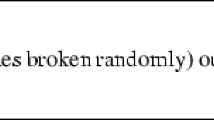Abstract
We give a new proof for the fact that the expected gap between the maximum load and the average load in the two-choice process is bounded by (1 + o(1))loglogn, irrespective of the number of balls thrown. The original proof of this surprising result, due to Berenbrink et al. in [2], uses tools from Markov chain theory, and a sophisticated induction proof involving computer-aided calculations. We provide a significantly simpler and more elementary proof. The new technique allows us to generalize the result and derive new and often tight bounds for the case of weighted balls. The simplification comes at a cost of larger lower order terms and a weaker tail bound for the probability of deviating from the expectation.
Access this chapter
Tax calculation will be finalised at checkout
Purchases are for personal use only
Preview
Unable to display preview. Download preview PDF.
Similar content being viewed by others
References
Azar, Y., Broder, A., Karlin, A., Upfal, E.: Balanced allocations. SIAM J. Computing 29(1), 180–200 (1999)
Berenbrink, P., Czumaj, A., Steger, A., Vöcking, B.: Balanced allocations: The heavily loaded case. SIAM J. Computing 35(6), 1350–1385 (2006)
Berenbrink, P., Friedetzky, T., Hu, Z., Martin, R.: On weighted balls-into-bins games. Theor. Comput. Sci. 409(3), 511–520 (2008)
Dubhashi, D., Panconesi, A.: Concentration of Measure for the Analysis of Randomized Algorithms. Cambridge University Press (2009)
Karp, R., Luby, M., Meyer auf der Heide, F.: Efficient pram simulation on a distributed memory machine. In: STOC, pp. 318–326 (1992)
Mitzenmacher, M., Richa, A.W., Sitaraman, R.: The power of two random choices: A survey of techniques and results. In: Handbook of Randomized Computing, pp. 255–312. Kluwer (2000)
Mitzenmacher, M., Vcking, B.: The asymptotics of selecting the shortest of two, improved. In: Allerton, pp. 326–327 (1998)
Pagh, R.: Hashing 2. Slides for the MADALGO Summer School on Data Structures (2013), http://www.madalgo.au.dk/html_sider/2_5_Events/SS2013/Course_material2013.html
Peres, Y., Talwar, K., Wieder, U.: The (1 + beta)-choice process and weighted balls-into-bins. In: SODA 2010, pp. 1613–1619 (2010)
Raab, M., Steger, A.: “Balls into bins” - A simple and tight analysis. In: Rolim, J.D.P., Serna, M., Luby, M. (eds.) RANDOM 1998. LNCS, vol. 1518, pp. 159–170. Springer, Heidelberg (1998)
Talwar, K., Wieder, U.: Balanced allocations: the weighted case. In: STOC, pp. 256–265 (2007)
Vöcking, B.: How asymmetry helps load balancing. J. ACM 50(4), 568–589 (2003)
Wieder, U.: Ballanced allocations with heterogenous bins. In: SPAA, pp. 188–193 (2007)
Author information
Authors and Affiliations
Editor information
Editors and Affiliations
Rights and permissions
Copyright information
© 2014 Springer-Verlag Berlin Heidelberg
About this paper
Cite this paper
Talwar, K., Wieder, U. (2014). Balanced Allocations: A Simple Proof for the Heavily Loaded Case. In: Esparza, J., Fraigniaud, P., Husfeldt, T., Koutsoupias, E. (eds) Automata, Languages, and Programming. ICALP 2014. Lecture Notes in Computer Science, vol 8572. Springer, Berlin, Heidelberg. https://doi.org/10.1007/978-3-662-43948-7_81
Download citation
DOI: https://doi.org/10.1007/978-3-662-43948-7_81
Publisher Name: Springer, Berlin, Heidelberg
Print ISBN: 978-3-662-43947-0
Online ISBN: 978-3-662-43948-7
eBook Packages: Computer ScienceComputer Science (R0)




